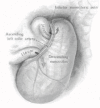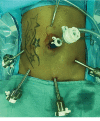Identification and Repair of Left-Sided Paraduodenal Hernia Using Both Laparoscopic and Robotic Techniques
- PMID: 32089943
- PMCID: PMC7025034
- DOI: 10.1155/2020/7569530
Identification and Repair of Left-Sided Paraduodenal Hernia Using Both Laparoscopic and Robotic Techniques
Abstract
Internal hernias are an uncommon cause of small bowel obstruction and present a challenging clinical diagnostic scenario. They result from the abnormal protrusion of an abdominal organ through a peritoneal defect and can cause intermittent obstructive symptoms, diffuse abdominal discomfort, and postprandial pain. Paraduodenal hernias comprise 53% of all internal hernias 1 and occur due to failure of the fixation of either the left or transverse mesocolon to the posterior abdominal wall. Its relative rarity results in mortality between 20 and 50% 2 because of delayed diagnosis and consequent obstruction, strangulation, and bowel ischemia. Our case series describes three patients before and after operative fixation of paraduodenal hernia. Only one of the three was identified by preoperative radiologist interpretation. Subsequent diagnosis and definitive treatment were completed by surgical staff to resolve undiagnosed undulating abdominal pain and obstructive-type symptoms. We further analyze left-sided paraduodenal hernias after laparoscopic and robotic repair to define common symptomatology, typical CT findings, and preferred laparoscopic repair techniques.
Copyright © 2020 Muhonen John et al.
Conflict of interest statement
The authors report no conflict of interests.
Figures





References
-
- Kim D., Calder B., Smith A., Streck C. An unusual cause of small bowel obstruction in a pediatric patient: Right-Sided paraduodenal hernia. The American Surgeon. 2018;84(9):e350–e351. Brief Reports. - PubMed
Publication types
LinkOut - more resources
Full Text Sources

